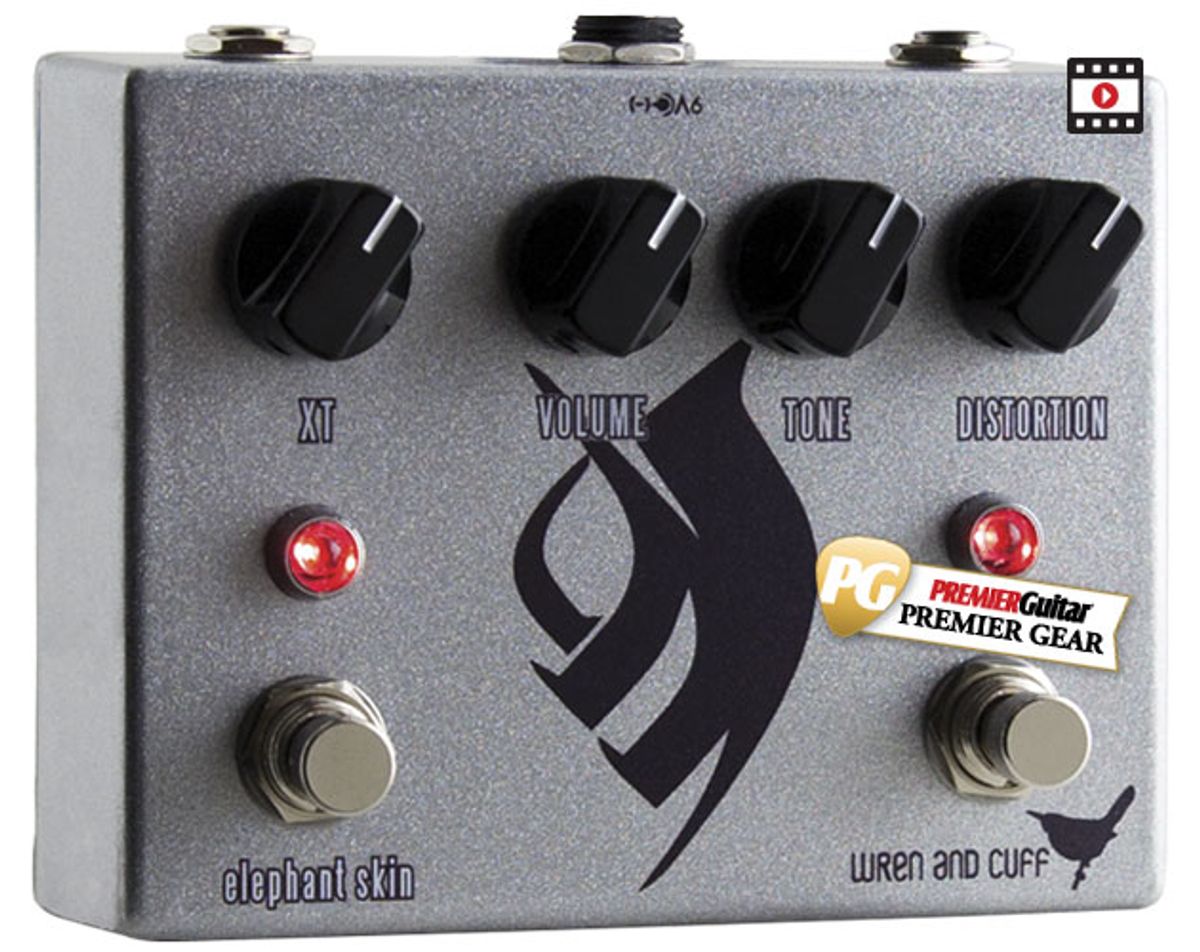Wren and Cuff and Mastodon’s Troy Sanders collaborate to bring life to a bass-fuzz monster.
All recorded playing through Gallien-Krueger 400RB and Ampeg 8x10
Clip 1 - XT mode engaged and set at 2 o'clock, volume at noon, tone at 1 o'clock, distortion at 1 o'clock.
Clip 2 - XT mode off, volume at 1 o'clock, tone at 2 o'clock, distortion at 2 o'clock.
Mastodon’s Troy Sanders is considered by many to be one of the more consummate modern-metal bassists. His lines run the gamut from simple to spider-like, and are often delivered in a rumbling, fuzzed-out package courtesy of his well-loved Wren and Cuff Tall Font Russian. A collaboration between Sanders and the SoCal pedal manufacturer made perfect sense, and the result is the Elephant Skin bass fuzz. The concept behind its design was simple: Start with the company’s Tall Font Russian, but offer up more saturation and volume in a footswitchable format.
Heart of Darkness
The beating heart of the Elephant Skin is the same exact circuit as the Tall Font Russian’s—which is the company’s take on the boxier-sounding ’90s Sovtek Big Muff series—and not modified in any way. The pedal houses controls for volume, tone, distortion, and the amount of gain boost (labeled XT). The latter only comes into play when a dedicated footswitch is activated. The boost circuit contains an extra gain stage that’s placed before the fuzz circuit and it can be used by itself for clean boosting or for pushing the gain over the edge when cascaded into the fuzz circuit.
Ratings
Pros:
Excellent clarity with high gain. Highly responsive to attack. Easy to use. Boost function enables quick changes between high- and low-gain settings.
Cons:
Heavy saturation only possible at higher ranges of the gain knob. Pricey.
Tones:
Ease of Use:
Build/Design:
Value:
Street:
$249
Wren and Cuff Elephant Skin
wrenandcuff.com
To get a feel for the Elephant Skin, I used a Fender P and a trusty Gallien-Krueger 400RB paired with an Ampeg 8x10. I got started with the pedal’s volume at 11 o’clock, the tone at noon, and the gain at 1 o’clock. Like the stompboxes that inspired it, the Elephant Skin adeptly translated the instrument’s fierce low end with a tight and enormously full delivery that didn’t muddy up with harder fingerpicking.
Red Star Power
Also aiding the articulation was the pedal’s finely tuned midrange scoop. This subtle emphasis in the midrange made it easy to detect the growl of my bass within the context of the full band—a quality of the original “tall-font” Sovtek Muffs that made them so popular with bassists. Likewise, the pedal’s treble frequencies also delivered the unique edginess exhibited by original tall-font pedals. They grew slightly raspier as I bumped the gain up to around 4 o’clock, which gave my tone a little more high-end cut to help slice through.
Like its Sovtek ancestors, the Elephant Skin doesn’t have much saturation compared to most Muffs and Muff-style circuits, and that gives the tone more room to breathe without becoming overly compressed. Its volume output is also lower (3 o’clock was unity volume in my case). But for sludgier tones, I had to nearly max it out. This is where the boost function really came in handy. I could dial in the boost-bypassed tone to a low or medium fuzz with a small amount of grit, and then set the boost knob almost all the way up to drive that tone into instant overblown chaos whenever I stomped on the boost switch. This may seem old hat if you’ve been running a boost into a Muff for years, but few pedals have integrated the trick as cleanly as the Elephant Skin.
The Verdict
The simplicity, earth-moving tone, and handy boost functionality of Wren and Cuff’s Elephant Skin make it worthy of the attention of any bassist with heavier proclivities. An absence of bells and whistles make it a cinch to dial up mammoth fuzz sounds in no time, but don’t be surprised if some of those tones require you to dial the volume and gain knobs full-tilt. Still, you shouldn’t let that deter you from checking the Elephant Skin out. It’s one of the more impressive options for high-gain bass fuzz out there.
Watch the Review Demo:



